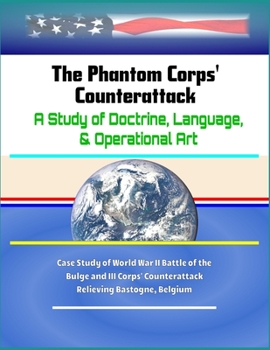The Phantom Corps' Counterattack: A Study of Doctrine, Language, & Operational Art - Case Study of World War II Battle of the Bulge and III Corps' Cou
Doctrine influences how the U.S. Army fights, by guiding actions of individuals and units during the uncertainty of combat, and various other martial affairs in preparedness for the nature of war. The U.S. Army fought World War II applying the doctrine of two key publications Field Service Regulations, Field Manual 100-5, Operations (1941 & 1944), and 100-15 Larger Units (1942). The conceptual framework created by these doctrines entailed strategy and tactics. Later in the Cold War, the U.S. Army's AirLand Battle doctrine's conceptual framework partitioned war into three levels: the strategic, operational, and tactical. Operational art emerges into the U.S. Army lexicon as a tool for creating a shared understanding in applying the new conceptual framework of the operational level of war. Commanders and their staffs apply operational art to bridge the strategic purpose with tactical actions. Today, Field Manual 3-0, Operations demonstrates that doctrine continues to evolve to reduce uncertainty and is increasingly relying on the operational art lessons from the past, specifically in large-scale combat. Applying today's conceptual framework to the U.S. Army's largest battle's counterattacking corps provides a new analysis on doctrine, language, operational art, and the relief of Bastogne, Belgium.This compilation also includes a reproduction of the 2019 Worldwide Threat Assessment of the U.S. Intelligence Community.The latest publication of FM 3-0, Operations (2017), places a new doctrinal emphasis for the U.S. Army on large-scale combat operations. This focus wants to ensure the U.S. military is a formidable deterrent against peer competitors, and build readiness for existential threats in an age of uncertainty. Except for the short Persian Gulf War of 1990-91, the U.S. Army has not fought a peer adversary in conventional war since World War II. Therefore, it is essential to understand lessons from past conflicts to facilitate readiness for today's U.S. Army for large-scale combat. The operational level of war and the application of operational art play essential roles in building the U.S. Army's readiness for future conflict through the anticipation of requirements, and facilitating arranging success through the application of operational art. History provides the U.S. Army examples of commanders who anticipated opportunities, then applied astute planning, and maneuver to achieve objectives of a battle, campaign, or war. The Battle of the Bulge was the U.S. Army's largest battle during World War II, and the largest battle fought in its history. As the U.S. Army continues to concentrate on large-scale combat operations in response to today's global security environment, the initial counterattacking corps during the Battle of the Bulge offers lessons in the operational level of war, and the successful use of operational art, against existential threats during a time of uncertainty.
Format:Paperback
Language:English
ISBN:1700548875
ISBN13:9781700548870
Release Date:January 1
Publisher:Independently Published
Length:94 Pages
Weight:0.53 lbs.
Dimensions:0.2" x 8.5" x 11.0"
Related Subjects
HistoryCustomer Reviews
0 rating





